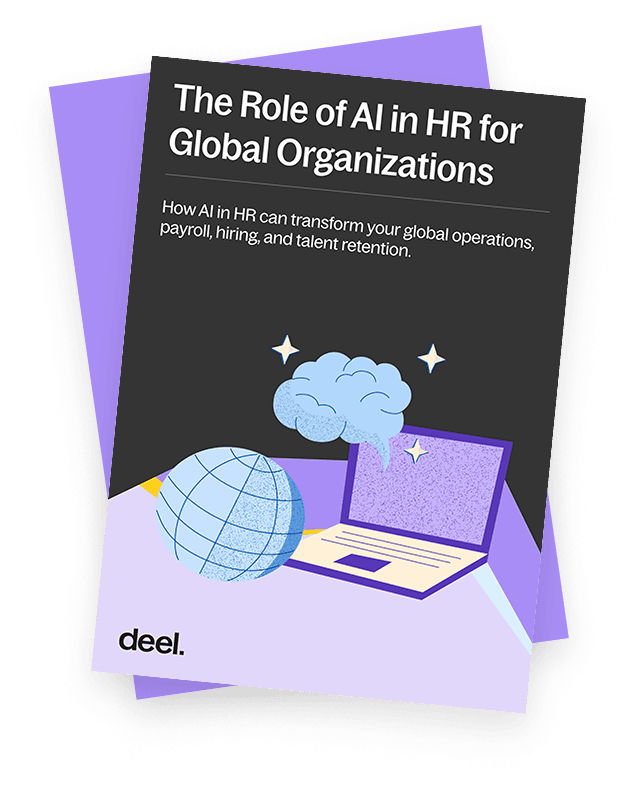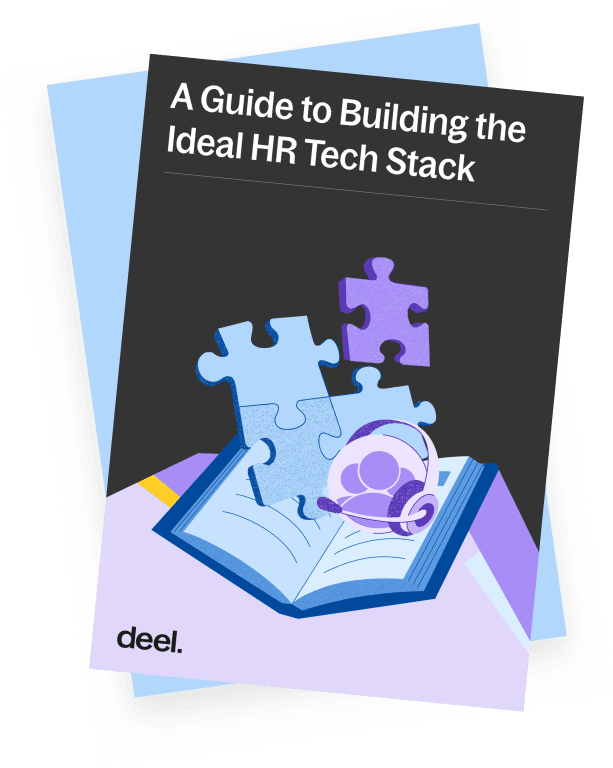Article
7 min read
AI in HR Management: How Does It Mesh with European AI Regulation?
AI
Global HR

Author
Deel Team
Last Update
March 05, 2025
Published
July 03, 2024

Key takeaways
- AI has transformed HR by automating tasks and providing data-driven insights, enhancing efficiency and effectiveness
- While AI boosts efficiency, it introduces new risks and concerns, which is why the EU is moving to regulate its use
- Approaching AI with care for ethics, transparency, and data protection is vital for HR professionals
Technology has become a cornerstone of HR practices, from streamlined recruitment processes to data-driven decision-making, enhancing their efficiency and effectiveness. Advanced tools and platforms have enabled the automation of time-consuming and repetitive tasks and HR departments are now recognized as strategic partners in organizational growth.
In this post, we will look at how the use of AI is changing the face of HR and People Operations, from streamlining administrative tasks and workflows to facilitating performance reviews and career development. We explore how these shifts HR processes can be approached and interact with EU regulations around AI models and data privacy and protection.
Understanding Artificial Intelligence in HR
AI is a vast and complex field in constant evolution, so staying informed and up-to-date can feel daunting, especially as an outsider, but it doesn’t have to be. Here are some AI concepts that closely relate to the future of HR and will help you approach the topic.
- Machine learning (ML): A subset of AI, ML involves the setup of algorithms that allow computers to identify patterns and make predictions or decisions without explicit programming
- Natural language processing (NLP): NLP enables computers to understand, interpret, and generate human language, facilitating communication between machines and humans
- Deep learning A subset of ML that involves multi-layered neural networks, allowing systems to learn and represent data through hierarchical abstraction automatically
- Neural networks: These are interconnected nodes, based on the human brain, that process information, enabling machines to recognize patterns and make decisions
- Algorithmic bias: The concept that AI algorithms may exhibit biases based on the data they are trained on, leading to potential discrimination or unfairness
- Ethical AI: The development and use of AI systems with a focus on ethical considerations, ensuring fairness, transparency, and accountability in decision-making processes
- Explainable AI (XAI): The idea that AI systems should provide clear and understandable explanations for their decisions, promoting transparency and trust
- Supervised learning: A type of ML where models are trained on labeled datasets, making predictions based on input data and known output labels
- Unsupervised learning: ML approach where models analyze data without predefined labels, identifying patterns or relationships on their own.
While the potential of AI to improve people operations tasks and processes is significant, HR tasks will still require some form of human touch, some more than others. This is due to the sensitivity of handling personal data and the human nature of HR work. In any case, below are some of the HR processes that can benefit the most from using AI.
- Job description writing and management: One valuable use case for the use of generative AI is the creation of job role descriptions based on standardized templates
- Recruitment and candidate screening: AI can streamline the talent acquisition process by automating resume screening, analyzing candidate profiles, and identifying ideal new hires based on predefined criteria
- Employee onboarding AI-driven onboarding processes can personalize orientation programs, offering tailored information and training modules based on the individual needs of new employees
- Performance management and feedback: AI enables continuous performance monitoring, providing real-time feedback to employees based on objective data. It can also predict performance trends, facilitating proactive interventions
- Employee development and training: AI-driven learning platforms can assess employee skills, preferences, and learning styles to deliver personalized training programs, ensuring more effective skill development
- Employee engagement surveys: AI can analyze sentiment in employee feedback and engagement surveys, providing insights into employee satisfaction, concerns, and areas for improvement
- Workforce planning and predictive analytics AI helps organizations forecast future workforce needs by analyzing historical data, turnover rates, and market trends, facilitating more accurate strategic planning
- Talent management: AI systems can assist in identifying and nurturing talent within the organization, helping HR teams make informed decisions about promotions, career paths, and skill development
- Compensation and benefits analysis: AI can analyze market trends, industry benchmarks, and employee performance data to optimize compensation and benefits packages, ensuring competitiveness in the market
- Diversity and inclusion initiatives AI can help identify and rectify biases in HR processes, promoting diversity and inclusion by ensuring fair and unbiased decision-making in recruitment, performance assessments, and promotions
- Employee exit interviews and predictive turnover analysis: AI can analyze exit interview data and historical turnover patterns to predict and address potential future turnover, enabling proactive retention strategies
With Deel, we have an easy remote work solution powered by a user-friendly platform and a seamless process. This has been helpful in ensuring we didn’t lose key staff and the deep corporate knowledge and skills that are hugely beneficial to our business.
—Lysette Randall,
Executive, HR Performance & Partnering, Quantium
Potential concerns associated with AI in HR
Despite its clear benefits, adopting AI in HR may also introduce certain risks, with bias and discrimination chief among them. For instance, if AI algorithms are trained on flawed and biased data or reflect existing organizational biases, they may inadvertently perpetuate and amplify these issues. HR departments must continually monitor and refine algorithms and processes to address this risk, ensuring fairness and mitigating biases.
How data is processed and stored is another essential consideration organizations must reflect upon when introducing AI to their people management processes. As mentioned above, the types of data managed by HR teams are sensitive by nature, but their correct handling isn’t just a matter of ethics and respect for privacy. It is often a matter of legal compliance, with different regulations across the world imposing standards for personal data collection and management (and hefty penalties for its misuse), like the European GDPR, Canada’s PIPEDA, or California’s CCPA.
Another concern revolves around potential employee resistance and lack of trust. Introducing AI may raise apprehensions about job security and privacy invasion. Building and maintaining trust is crucial, requiring transparent communication about AI’s purpose and use, addressing employee concerns, and involving them in the process.
To address these concerns, institutions are beginning to address AI and develop regulations to support its development while keeping any drawbacks in check.

The EU AI Act
The AI Act is the world’s first comprehensive legal framework on artificial intelligence. It is part of a broader set of policy measures, including the AI Innovation Package and the Coordinated Plan on AI, all working towards trustworthy AI development.
Key provisions and goals
The Act:
- Bans and prohibits AI practices posing unacceptable risks
- Defines high-risk applications and sets clear requirements for them
- Establishes obligations for providers and deployers of high-risk AI
- Requires conformity assessment before putting AI systems on the market
- Enforces governance structures at European and national levels
Risk-based approach
The Regulatory Framework categorizes AI systems into four risk levels. How an AI system is rated and what limitations and regulations it must abide by depend on its level of risk. The four risk levels are listed below:
1. Unacceptable risk AI systems
The classification of AI systems under unacceptable risk occurs when they are identified as potential threats to individuals. These systems are not allowed. Instances of unacceptable risk AI systems include:
- Social scoring systems
- Systems designed to manipulate children or other vulnerable groups
- Real-time remote biometric systems
2. High-risk AI systems:
AI systems that can negatively affect safety or fundamental rights are considered high-risk.
These are systems subject to strict obligations, including risk assessment, high-quality datasets, documentation, human oversight, and cybersecurity measures. They include systems that deal with:
- Critical infrastructures
- Education
- Safety components
- Employment
- Essential services
- Law enforcement
- Migration and asylum
- Democratic processes
3. Limited-risk AI systems:
Limited risk is associated with a lack of transparency in AI usage. It refers primarily to systems like:
- Advanced generative AI models like ChatGPT 4
- Chatbots
- Deep fake media
The AI Act introduces transparency obligations, ensuring humans are informed that the systems they interact with, or their output, are AI-generated.
4. Minimal or no-risk AI:
Most AI systems in the EU fall into the minimal-risk category and can be used freely. These include instances like:
- Video games
- Spam filtersMajority of AI systems in the EU fall into this category
How the EU AI Act impacts HR practices
Beyond using AI tools that are correctly classified and legally allowed, the AI Act invites users of AI models to keep certain considerations at the center of their strategies and processes. It’s therefore important for HR leaders planning to implement AI into their workflow to always reflect on points that include the ones listed below.
Ethical considerations and AI transparency
The European AI regulation strongly emphasizes ethical considerations, requiring HR practices to prioritize fairness, accountability, and transparency. AI algorithms used in recruitment, performance assessment, and other HR functions must be transparent, ensuring that decisions are explainable and unbiased. This provision aligns with the broader goal of fostering trust in AI systems among employees and stakeholders.
Data protection and privacy concerns
HR departments must be vigilant in upholding the regulation’s data protection and privacy standards. The legislation requires explicit consent for data processing, ensuring that personal information is handled responsibly. HR systems leveraging AI must implement robust measures to safeguard employee data, promoting a culture of trust and compliance with stringent privacy regulations.
Accountability and responsibility in AI decision-making
The regulation mandates that organizations bear accountability for the decisions made by their AI systems, especially in critical HR matters. HR professionals are tasked with ensuring that AI algorithms are accurate, effective, and aligned with ethical standards. This provision emphasizes the need for organizations to take responsibility for the impact of AI on their workforce, mitigating potential biases and discriminatory outcomes.
Human oversight and intervention requirements
The EU regulation also stipulates the necessity of human oversight and intervention in decision-making processes to address the abovementioned concerns. In HR, this means that while AI-powered tools can enhance efficiency, human professionals must retain the ability to intervene, review, and adjust AI-generated decisions.
Strategies for aligning AI practices with European AI regulations
Building ethical AI frameworks
HR departments must prioritize the development of ethical AI frameworks that align with the values outlined in the European AI regulation. This involves:
- Establishing guidelines for responsible AI use
- Ensuring fairness, accountability, and transparency throughout the AI lifecycle
Ensuring transparent AI algorithms
Transparency is an essential requirement under the European AI regulation, necessitating HR professionals to ensure that AI algorithms are understandable and explainable. This involves providing clear insights into how AI systems operate and make decisions. Organizations can achieve transparency by:
- Documenting their AI processes
- Making information accessible to employees
- Addressing any potential opacity in algorithmic decision-making
Establishing robust data protection measures
Compliance with data protection and privacy standards is paramount. HR teams should implement robust measures to safeguard employee data, ensuring its confidentiality and integrity. This includes:
- Obtaining explicit consent for data processing
- Implementing data minimization practices
- Regularly auditing data security measures to align with the stringent requirements of the European AI regulation
Incorporating human-centric approaches in AI applications
To meet the human oversight and intervention requirements, HR professionals should design AI applications with a human-centric approach. This involves integrating mechanisms that allow human professionals to intervene, review, and adjust AI-generated decisions.
So the regulations are clear, and we understand how things should work, but how does a compliant approach to HR work in practice?
In addition to continuously training and improving our models, anytime we have questions not in our knowledge base, we have a 24-hour SLA to create the content with our team of over 40 compliance experts, making sure we have the most up-to-date and accurate answers possible. On the infrastructure side, we also built some powerful technology to ensure our clients' data is protected while still available through generative AI.
—Aaron Goldsmid,
Head of Product, Payments & Integration

Embrace the future of HR with Deel
The dynamic nature of both AI and regulatory frameworks underscores the need for continuous learning and adaptation. In this rapidly evolving landscape, HR leaders must stay informed about the latest developments in AI technology and regulatory requirements. HR professionals should actively participate in industry forums, engage in continuous professional development, and collaborate with regulatory bodies to shape AI’s responsible and ethical integration in human resources.
This way, HR teams can proactively navigate the challenges and opportunities that arise. Embracing this proactive approach will ensure compliance and position HR as a critical driver of innovation and positive organizational change.
Deel is at the forefront of future-of-work technologies, including AI. From globally compliant contracts to worker mobility to a full HR management suite of tools, we ensure workers and employers worldwide can focus on delivering their best work while we care for the rest.















